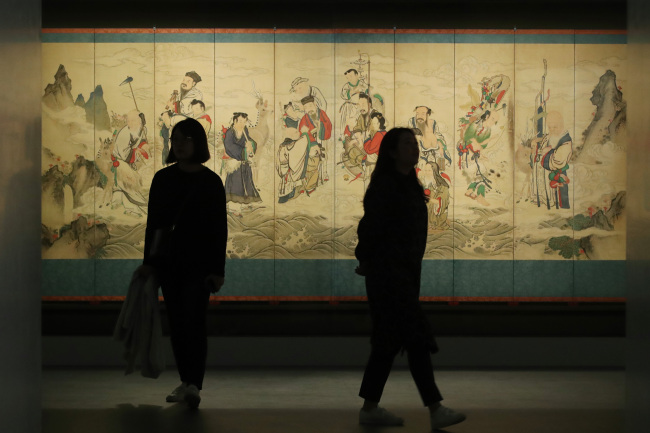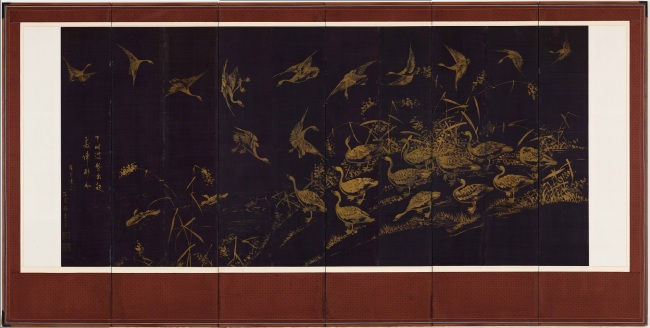Folding screens are a traditional form of art that was popular in Asia in the 19th and 20th centuries. The paneled artworks featuring paintings, patterns and calligraphy were used to decorate rooms, to highlight the presence of a powerful figure or as a backdrop for various ceremonies and rituals.
The Amorepacific Museum of Art’s “Beyond Folding Screens” is a large-scale exhibition that brings the folding screen to the fore.
 |
“The Sun, Moon and Five Peaks,” an emblem of royal authority produced in the late 19th century, is on loan from the National Palace Museum of Korea. (APMA) |
The exhibition features 76 folding screens, including many produced during the Joseon period as well as some from Korea’s modern era.
“Korea’s production of folding screens was very active during the Joseon era, but they have hardly been introduced abroad, whereas those from China and Japan were exported and beloved by people from the West,” curator Pyun Ji-hye told the Korea Herald.
“In the 18th and 19th centuries, folding screens were an important export item for the Qing dynasty. Those from Japan also were popular in the West, whereas Joseon folding screens did not get (many) chances to travel abroad,” Pyun explained. “While the folding screens from China and Japan received much attention through exhibitions and research, those of Joseon remain relatively unknown.”
The works on display, produced by court painters as well as individuals, come from the museum’s collection and private collectors as well as 10 other institutions, including the National Museum of Korea, the National Palace Museum of Korea, the National Folk Museum of Korea and Leeum, Samsung Museum of Art.
The first work on view is a 10-panel folding screen bearing the image of Geumgangsan, whose sheer size awes the viewers. This is followed by “Taoist Immortals Crossing the Sea.” King Gojong presented the 10-panel folding painting to Carl Andreas Wolter, a German co-founder of Korea’s first trading company, upon his return to his home country.
The next section is dedicated to folding screens produced in the royal court, including “The Sun, Moon and Five Peaks,” which was placed behind the king’s throne as an emblem of the royal authority of a king during the Joseon period.
 |
Visitors at Amorepacific Museum of Art walk by “Taoist Immortals Crossing the Sea.” (Yonhap) |
“Korean folding screens first started in the royal court then later spread to the civilian sector. They were used to decorate various court ceremonies, banquets and rituals,” Pyun said.
“Like how we take pictures when we travel, the people from the court also painted royal occasions on the folding screens and shared them with the participants. The finest work was presented to the sovereign.
“When speaking of folding screens, people perhaps think of something boring and old, but there are various cultural and historical spectrums to look into. Folding screens have different meanings and served different purposes.”
The sections that followed included folding screens featuring “minhwa,” or folk paintings, and works by modern artists.
 |
Late Joseon court painter Yang Gi-hun’s “Geese and Reeds,” a six-panel folding screen, is on loan from Ewha Womans University Museum. (APMA) |
Late 19th-century court painter Yang Gi-hun’s “Geese and Reeds,” painted in gold paint on black silk, and court painter Yi Han-cheol’s “Fish and Crab” are other noteworthy works.
20th-century Korean painter Kim Ki-chang’s “Haenyeo,” featuring the famous female divers of Jeju Island, is also on show.
The exhibition “Beyond Folding Screens” runs through Dec. 23.
By Shim Woo-hyun (
ws@heraldcorp.com)










